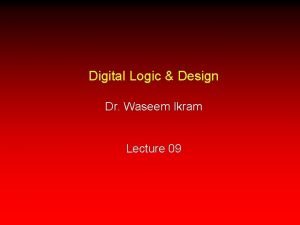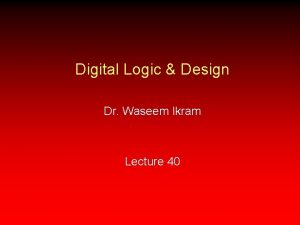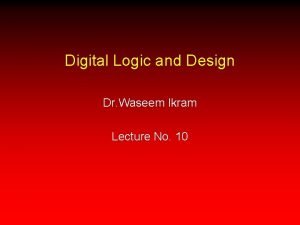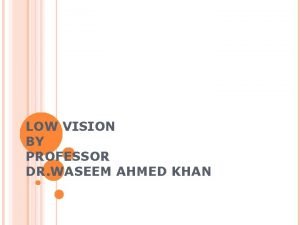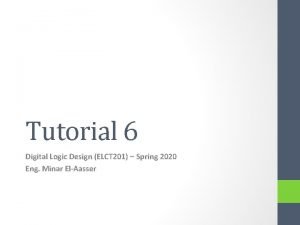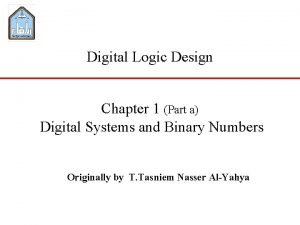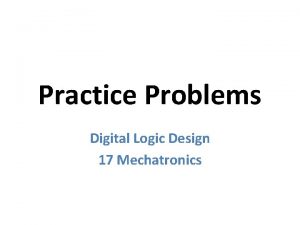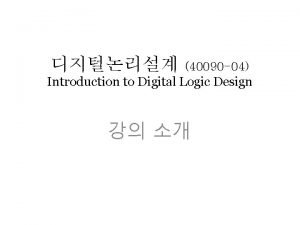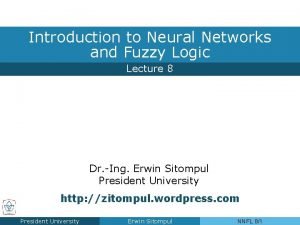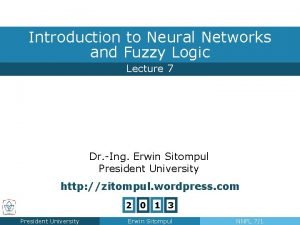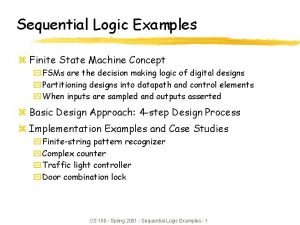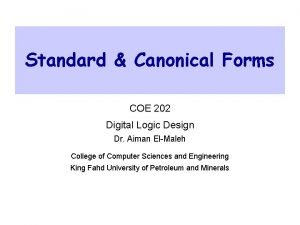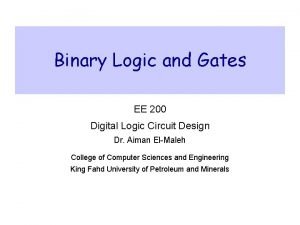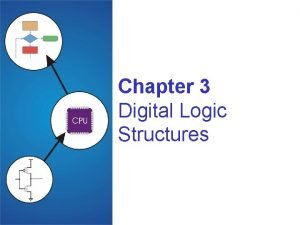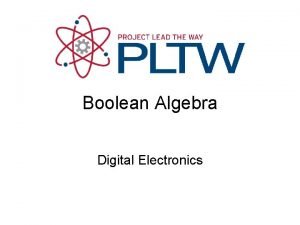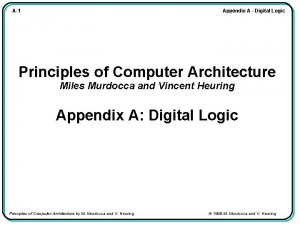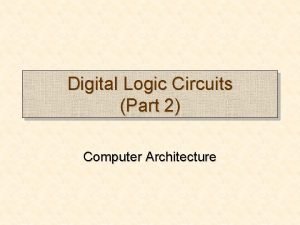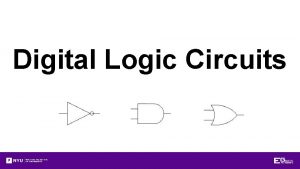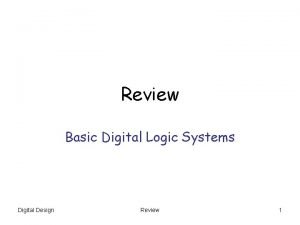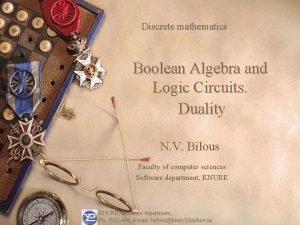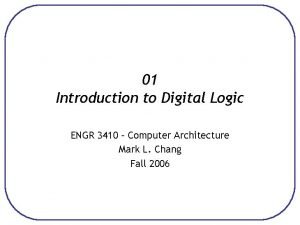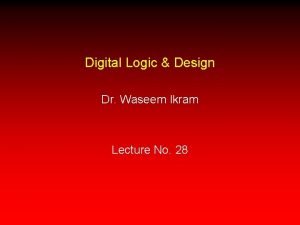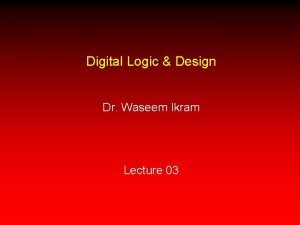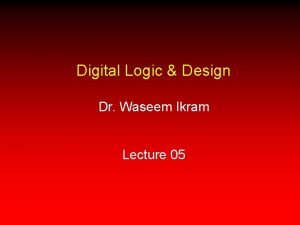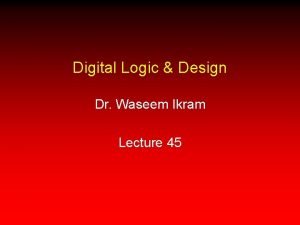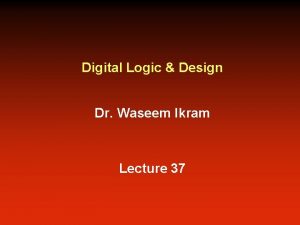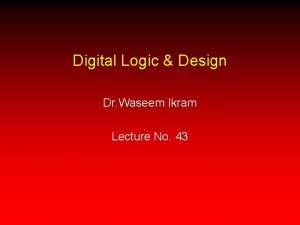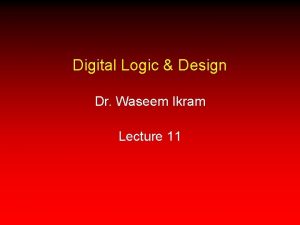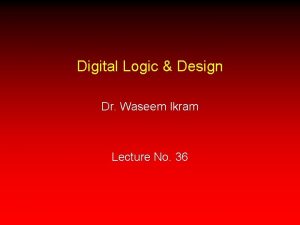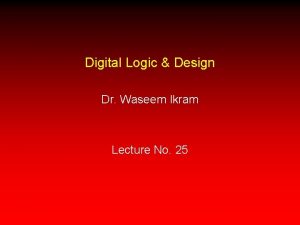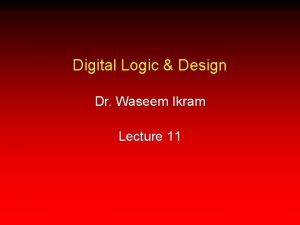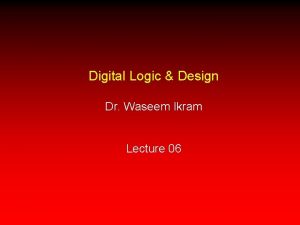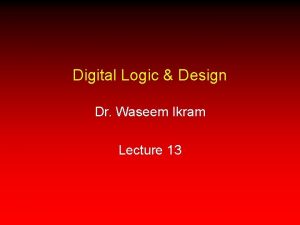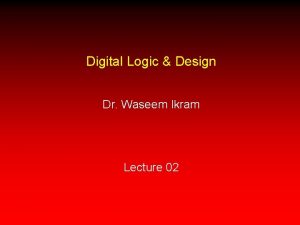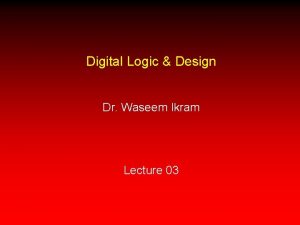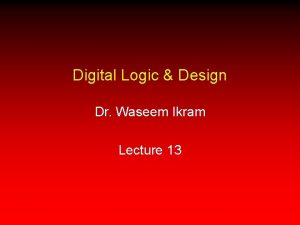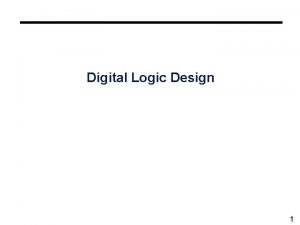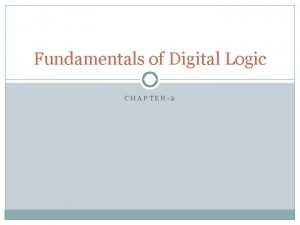Digital Logic Design Dr Waseem Ikram Lecture 01










































- Slides: 42

Digital Logic & Design Dr. Waseem Ikram Lecture 01

Analogue Quantities Continuous Quantity n Intensity of Light n Temperature n Velocity

Digital Values n Discrete set of values

Continuous Signal

Continuous Signal

Digital Representation

Under Sampling

Electronic Processing n n n Analogue Systems Digital Systems Representing quantities in Digital Systems

Representing Digital Values 39 0 C ? 6. 25 x 1018 ? Digital System 39 m. V 6. 25 x 1015 V !!

Digital Systems n n Two Voltage Levels Two States n On/Off n Black/White n Hot/Cold n Stationary/Moving

Binary Number System n n n Binary Numbers Representing Multiple Values Combination of 0 v & 5 v

Merits of Digital Systems n n n Efficient Processing & Data Storage Efficient & Reliable Transmission Detection and Correction of Errors Precise & Accurate Reproduction Easy Design and Implementation Occupy minimum space

Information Processing n n n Numbers Text Formula and Equations Drawings and Pictures Sound and Music

Logic Gates n n Building Blocks AND, OR and NOT Gates NAND, NOR, XOR and XNOR Gates Integrated Circuits (ICs)

10 9 8 5 6 GND 11 12 13 Vcc Logic Gate Symbol and ICs 4 3 2 1 7400

Combinational Circuits n n Combination of Logic Gates Adder Combinational Circuit

Adder Combinational Circuit Sum Carry

Functional Devices n Adders n Comparators n Encoders/Decoders n Multiplexers/Demultiplexers

Sequential Circuits n n Memory Element Current & Previous State Flip-Flops Counters & Registers

Block Diagram of a Sequential Circuit

Programmable Logic Devices (PLDs) n n n Configurable Hardware Combinational Circuits Sequential Circuits Low chip count Lower Cost Short development time

Memory n n n Storage RAM (Random Access Memory) n Read-Write n Volatile ROM (Read-Only Memory) n Read-Only n Non-Volatile

A/D & D/A Converters n n n Processing of Continuous values Conversion n Analogue to Digital A/D n Digital to Analogue D/A Industrial Control Application

Digital Industrial Control x 1 */* u 1 Digital x 1 */* u 1 Controller A/D D/A Converter Thermocouple Reaction Vessel Heater Control

Summary n n Continuous Signals Digital Representation in Binary Information Processing Logic Gates

Summary n n Combinational & Sequential Circuits Programmable Logic Devices (PLDs) Memory (RAM & ROM) A/D & D/A Converters

Number Systems and Codes n n n Decimal Number System Caveman Number System Binary Number System Hexadecimal Number System Octal Number System

Decimal Number System n n Ten unique numbers 0, 1. . 9 Combination of digits Positional Number System 275 = 2 x 102 + 7 x 101 + 5 x 100 n Base or Radix 10 n Weight 1, 100, 1000 ….

Representing Fractions n Fractions can be represented in decimal number system in a manner = 3 x 102 + 8 x 101 + 2 x 100 + 9 x 10 -1 + 1 x 10 -2 = 300 + 80 + 2 + 0. 9 + 0. 01 = 382. 91

Caveman Number System n n n ∑, ∆, >, Ω and ↑ Base – 5 Number System ∆Ω↑∑ = 220

Caveman Number System Decimal Number Caveman Number 0 ∑ 10 >∑ 1 ∆ 11 >∆ 2 > 12 >> 3 Ω 13 >Ω 4 ↑ 14 >↑ 5 ∆∑ 15 Ω∑ 6 ∆∆ 16 Ω∆ 7 ∆> 17 Ω> 8 ∆Ω 18 ΩΩ 9 ∆↑ 19 Ω↑

Caveman Number System n Mr. Caveman is using a base 5 number system. Thus the number ∆Ω↑∑ in decimal is = ∆ x 53 + Ω x 52 + ↑ x 51 + ∑ x 50 = ∆ x 125 + Ω x 25 + ↑ x 5 + ∑ x 1 = (1) x 125 + (3) x 25 + (4) x 5 + (0) x 1 = 125 + 75 + 20 + 0 = 220

Binary Number System n n Two unique numbers 0 and 1 Base – 2 A binary digit is a bit Combination of bits to represent larger values

Binary Number System Decimal Number Binary Number 0 0 10 1010 1 1 11 1011 2 10 12 1100 3 11 13 1101 4 100 14 1110 5 101 15 1111 6 110 16 10000 7 111 17 10001 8 1000 18 10010 9 1001 19 10011

Combination of Binary Bits n n Combination of Bits 100112 = 1910 = (1 x 24) + (0 x 23) + (0 x 22) + (1 x 21) + (1 x 20) = (1 x 16) + (0 x 8) + (0 x 4) + (1 x 2) + (1 x 1) = 16 + 0 + 2 + 1 = 19

Fractions in Binary n n n Fractions in Binary 1011. 1012 = 11. 625 = (1 x 23) + (0 x 22) + (1 x 21) + (1 x 20) + (1 x 2 -1) + (0 x 2 -2) + (1 x 2 -3) = (1 x 8) + (0 x 4) + (1 x 2) + (1 x 1/2) + (0 x 1/4) + (1 x 1/8) = 8 + 0 + 2 + 1 + 0. 5 + 0. 125 = 11. 625 Floating Point Notations

Decimal-Binary Conversion n n Binary to Decimal Conversion n Sum-of-Weights n Adding weights of non-zero terms Decimal to Binary Conversion n Sum-of-Weights (in reverse) n Repeated Division by 2

Decimal to binary conversion using Sum of weight Number Weight Result after subtraction Binary 392 256 392 -256=136 128 136 -128=8 1 8 54 0 8 32 0 8 16 0 8 8 0 4 0 0 2 0 0 1 0 8 -8=0 1

Decimal-Binary Conversion n Binary to Decimal Conversion n Sum-of-Weights n Adding weights of non-zero terms Terms 16, 0, 0. 2 and 1 19

Decimal-Binary Conversion n Binary to Decimal Conversion n Sum-of-Weights n Adding weights of non-zero terms

Decimal-Binary Conversion n Binary to Decimal Conversion n Sum-of-Weights n Adding weights of non-zero terms

Lecture No. 1 Number Systems A Summary
 Waseem ikram
Waseem ikram Waseem ikram
Waseem ikram Waseem ikram
Waseem ikram Waseem ahmad khan
Waseem ahmad khan Schizotyp personality disorder
Schizotyp personality disorder Digital logic design tutorial
Digital logic design tutorial Digital logic design number system
Digital logic design number system Digital logic design practice problems
Digital logic design practice problems Digital logic design lectures
Digital logic design lectures Digital logic design
Digital logic design 01:640:244 lecture notes - lecture 15: plat, idah, farad
01:640:244 lecture notes - lecture 15: plat, idah, farad Fuzzy logic lecture
Fuzzy logic lecture Neural networks and fuzzy logic
Neural networks and fuzzy logic Logic sitompul
Logic sitompul First order logic vs propositional logic
First order logic vs propositional logic First order logic vs propositional logic
First order logic vs propositional logic First order logic vs propositional logic
First order logic vs propositional logic Combinational logic circuit vs sequential
Combinational logic circuit vs sequential Cryptarithmetic problem logic+logic=prolog
Cryptarithmetic problem logic+logic=prolog Project management plan example
Project management plan example Is it x y or y x
Is it x y or y x Combinational logic sequential logic 차이
Combinational logic sequential logic 차이 If x = 0 and y = 1, which output line is enabled?
If x = 0 and y = 1, which output line is enabled? Finite state machine verilog
Finite state machine verilog Timing diagram for and gate
Timing diagram for and gate Digital logic controller
Digital logic controller Canonical form digital logic
Canonical form digital logic Precedence of logic gates
Precedence of logic gates Digital logic structures
Digital logic structures The boolean expression
The boolean expression Bubble matching digital logic
Bubble matching digital logic Digital logic and computer architecture
Digital logic and computer architecture Uncommon logic digital
Uncommon logic digital Digital design review
Digital design review Law of duality in discrete mathematics
Law of duality in discrete mathematics Bubble matching digital logic
Bubble matching digital logic Practical design to eurocode 2
Practical design to eurocode 2 Urban design lecture
Urban design lecture Principles of interior design ppt
Principles of interior design ppt Lecture hall acoustic design
Lecture hall acoustic design Game design lecture
Game design lecture Computer aided drug design lecture notes
Computer aided drug design lecture notes Cmos vlsi design lecture notes
Cmos vlsi design lecture notes
